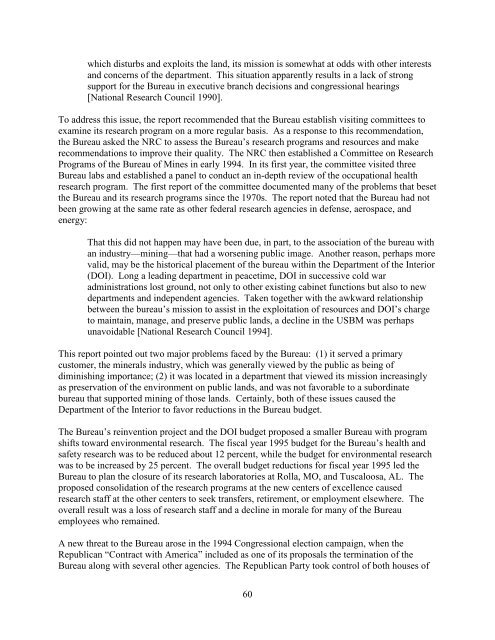One Hundred Years of Federal Mining Safety and Health Research
One Hundred Years of Federal Mining Safety and Health Research
One Hundred Years of Federal Mining Safety and Health Research
- No tags were found...
You also want an ePaper? Increase the reach of your titles
YUMPU automatically turns print PDFs into web optimized ePapers that Google loves.
which disturbs <strong>and</strong> exploits the l<strong>and</strong>, its mission is somewhat at odds with other interests<br />
<strong>and</strong> concerns <strong>of</strong> the department. This situation apparently results in a lack <strong>of</strong> strong<br />
support for the Bureau in executive branch decisions <strong>and</strong> congressional hearings<br />
[National <strong>Research</strong> Council 1990].<br />
To address this issue, the report recommended that the Bureau establish visiting committees to<br />
examine its research program on a more regular basis. As a response to this recommendation,<br />
the Bureau asked the NRC to assess the Bureau’s research programs <strong>and</strong> resources <strong>and</strong> make<br />
recommendations to improve their quality. The NRC then established a Committee on <strong>Research</strong><br />
Programs <strong>of</strong> the Bureau <strong>of</strong> Mines in early 1994. In its first year, the committee visited three<br />
Bureau labs <strong>and</strong> established a panel to conduct an in-depth review <strong>of</strong> the occupational health<br />
research program. The first report <strong>of</strong> the committee documented many <strong>of</strong> the problems that beset<br />
the Bureau <strong>and</strong> its research programs since the 1970s. The report noted that the Bureau had not<br />
been growing at the same rate as other federal research agencies in defense, aerospace, <strong>and</strong><br />
energy:<br />
That this did not happen may have been due, in part, to the association <strong>of</strong> the bureau with<br />
an industry—mining—that had a worsening public image. Another reason, perhaps more<br />
valid, may be the historical placement <strong>of</strong> the bureau within the Department <strong>of</strong> the Interior<br />
(DOI). Long a leading department in peacetime, DOI in successive cold war<br />
administrations lost ground, not only to other existing cabinet functions but also to new<br />
departments <strong>and</strong> independent agencies. Taken together with the awkward relationship<br />
between the bureau’s mission to assist in the exploitation <strong>of</strong> resources <strong>and</strong> DOI’s charge<br />
to maintain, manage, <strong>and</strong> preserve public l<strong>and</strong>s, a decline in the USBM was perhaps<br />
unavoidable [National <strong>Research</strong> Council 1994].<br />
This report pointed out two major problems faced by the Bureau: (1) it served a primary<br />
customer, the minerals industry, which was generally viewed by the public as being <strong>of</strong><br />
diminishing importance; (2) it was located in a department that viewed its mission increasingly<br />
as preservation <strong>of</strong> the environment on public l<strong>and</strong>s, <strong>and</strong> was not favorable to a subordinate<br />
bureau that supported mining <strong>of</strong> those l<strong>and</strong>s. Certainly, both <strong>of</strong> these issues caused the<br />
Department <strong>of</strong> the Interior to favor reductions in the Bureau budget.<br />
The Bureau’s reinvention project <strong>and</strong> the DOI budget proposed a smaller Bureau with program<br />
shifts toward environmental research. The fiscal year 1995 budget for the Bureau’s health <strong>and</strong><br />
safety research was to be reduced about 12 percent, while the budget for environmental research<br />
was to be increased by 25 percent. The overall budget reductions for fiscal year 1995 led the<br />
Bureau to plan the closure <strong>of</strong> its research laboratories at Rolla, MO, <strong>and</strong> Tuscaloosa, AL. The<br />
proposed consolidation <strong>of</strong> the research programs at the new centers <strong>of</strong> excellence caused<br />
research staff at the other centers to seek transfers, retirement, or employment elsewhere. The<br />
overall result was a loss <strong>of</strong> research staff <strong>and</strong> a decline in morale for many <strong>of</strong> the Bureau<br />
employees who remained.<br />
A new threat to the Bureau arose in the 1994 Congressional election campaign, when the<br />
Republican “Contract with America” included as one <strong>of</strong> its proposals the termination <strong>of</strong> the<br />
Bureau along with several other agencies. The Republican Party took control <strong>of</strong> both houses <strong>of</strong><br />
60
















